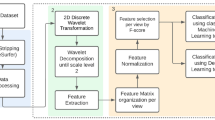Abstract
Color characteristics in combination with gray level co-occurrence matrix (GLCM) texture features of digital drawings were compared between cognitive healthy subjects (Control, n = 67) and individuals clinically diagnosed with amnestic mild cognitive impairment (aMCI, n = 32) or early Alzheimer’s dementia (AD, n = 56). It was hypothesized that these variables contribute to the detection of cognitive impairments. Between subject groups comparisons of texture entropy, homogeneity, correlation and image size were conducted were performed with Chi-Square and Kruskal-Wallis tests. The diagnostic power of combining all texture features as explanatory variables was analyzed with a logistic regression model and the area under curve (AUC) of the corresponding receiver operating control (ROC) curve was calculated to discriminate best between healthy and cognitive impaired subjects. Texture and color features differed significantly between subject groups. The AUC for discriminating the control group from patients with early AD was equal 0.86 (95% CI [0.80, 0.93], sensitivity = .80, specificity = .79), and the AUC for discriminating between healthy subjects and all cognitive impaired equal 0.82. (95% CI [0.75; 0.89], sensitivity = .76, specificity = .79) for discriminating healthy controls from MCI patients. Although the study results are very promising, further validation is needed, especially with a larger sample size.
Access this chapter
Tax calculation will be finalised at checkout
Purchases are for personal use only
Similar content being viewed by others
References
Alzheimer’s Association: Alzheimer’s disease facts and figures. Alzheimer’s Dement. 13, 325–373 (2017)
Trojano, L., Gainotti, G.: Drawing disorders in Alzheimer’s disease and other forms of dementia. J. Alzheimers Dis. 53, 31–52 (2016)
Shulman, K.I., Gold, D.P., Cohen, C.A., Zucchero, C.A.: Clock-drawing and dementia in the community: a longitudinal study. Int. J. Geriatr. Psychiatry 8, 487–496 (1993)
Ehreke, L., Luck, T., Luppa, M., Konig, H.H., Villringer, A., Riedel-Heller, S.G.: Clock drawing test - screening utility for mild cognitive impairment according to different scoring systems: results of the Leipzig Longitudinal Study of the Aged (LEILA 75+). Int. Psychogeriatr. 23, 1592–1601 (2011)
Heymann, P., et al.: Early detection of Alzheimer’s disease based on the patient’s creative drawing process: first results with a novel neuropsychological testing method. J. Alzheimers Dis. 63, 675–687 (2018)
Muller, S., Preische, O., Heymann, P., Elbing, U., Laske, C.: Diagnostic value of a tablet-based drawing task for discrimination of patients in the early course of Alzheimer’s disease from healthy individuals. J. Alzheimers Dis. 55, 1463–1469 (2017)
Robens, S., et al.: Digital picture co-occurrence texture characteristics discriminate between patients with early dementia of Alzheimer’s type and cognitive healthy subjects. In: Proceedings of the 12th International Joint Conference on Biomedical Engineering Systems and Technologies, vol. 5, pp. 88–93 (2019)
Haralick, R.M., Shanmugam, K., Dinstein, I.: Textural features of image classification. IEEE Trans. Syst. Man Cybern. 3, 610–621 (1973)
Pratiwi, M., Alexander, Harefa, J., Nanda, S.: Mammograms classification using gray-level co-occurrence matrix and radial basis function neural network. Procedia Comput. Sci. 59, 83–91 (2015)
Shirvaikar, M., Huang, N., Dong, X.N.: The measurement of bone quality using gray level co-occurrence matrix textural features. J. Med. Imaging Health Inform. 6, 1357–1362 (2016)
Parekh, R., Mittra, A.K.: Automated detection of skin diseases using texture features. Int. J. Eng. Sci. Technol. 3(6), 4801–4808 (2011)
Morris, J.C., et al.: The consortium to establish a registry for Alzheimer’s disease (CERAD). Part I. Clinical and neuropsychological assessment of Alzheimer’s disease. Neurology 39, 1159–1165 (1989)
Petersen, R.C.: Mild cognitive impairment as a diagnostic entity. J. Int. Med. 256, 183–194 (2004)
McKhann, G., Drachman, D., Folstein, M., Katzman, R., Price, D., Stadlan, E.M.: Clinical diagnosis of Alzheimer’s disease. Report of the NINCDS‐ADRDA Work Group* under the Auspices of Department of Health and Human Services Task Force on Alzheimer’s Disease, vol. 34, pp. 939–939 (1984)
Gragnaniello, D., Kessler, J., Bley, M., Mielke, R.: Copying and free drawing by patients with Alzheimer disease of different dementia stages. Nervenarzt 69, 991–998 (1998)
Kirk, A., Kertesz, A.: On drawing impairment in Alzheimer’s disease. Arch. Neurol. 48, 73–77 (1991)
Maurer, K., Prvulovic, D.: Paintings of an artist with Alzheimer’s disease: visuoconstructural deficits during dementia. J. Neural Transm. 111(3), 235–245 (2004)
Lee, Y.T., Tsai, Y.C., Chen, L.K.: Progressive changes in artistic performance of a Chinese master with Alzheimer’s disease. Cortex 69, 282–283 (2015)
Author information
Authors and Affiliations
Corresponding author
Editor information
Editors and Affiliations
Rights and permissions
Copyright information
© 2020 Springer Nature Switzerland AG
About this paper
Cite this paper
Robens, S., Ostermann, T., Heymann, P., Müller, S., Laske, C., Elbing, U. (2020). Comparison of Texture Features and Color Characteristics of Digital Drawings in Cognitive Healthy Subjects and Patients with Amnestic Mild Cognitive Impairment or Early Alzheimer’s Dementia. In: Roque, A., et al. Biomedical Engineering Systems and Technologies. BIOSTEC 2019. Communications in Computer and Information Science, vol 1211. Springer, Cham. https://doi.org/10.1007/978-3-030-46970-2_20
Download citation
DOI: https://doi.org/10.1007/978-3-030-46970-2_20
Published:
Publisher Name: Springer, Cham
Print ISBN: 978-3-030-46969-6
Online ISBN: 978-3-030-46970-2
eBook Packages: Computer ScienceComputer Science (R0)




